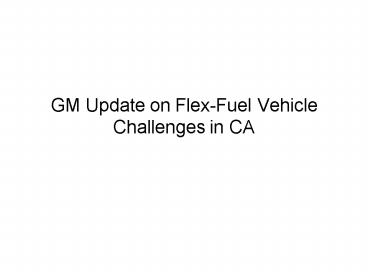GM Update on FlexFuel Vehicle Challenges in CA PowerPoint PPT Presentation
1 / 14
Title: GM Update on FlexFuel Vehicle Challenges in CA
1
GM Update on Flex-Fuel Vehicle Challenges in CA
2
California Emission Standardsand E85 Flex-Fuel
Vehicles
- FFVs fueled with E85 are generally cleaner than
gasoline vehicles - But there are conflicts between the California
emission standards and E85 FFVs that are causing
sales restrictions - FFVs fueled with E85 yield large reductions in
greenhouse gas emissions - But the California greenhouse gas regulations
provide no practical incentive for E85 FFVs
3
E85 Is Cleaner than Gasoline
- Flex-fuel vehicles are generally cleaner when
fueled with E85 than with gasoline - Tailpipe emissions are lower
- Lower NOx
- Lower CO
- HC about the same on a reactivity adjusted basis
- Evaporative emissions are lower
- Lower permeation
- Lower vapor pressure
4
Conflict Between California Standards E85 FFVs
- The most stringent categories of the California
emission standards present unique technical
challenges - California SULEV exhaust standard technical
challenges - Compliance required on E85 as well as gasoline
- Compliance required at normal temperature (75F)
and cold temperature (50F) - Control of non-methane organic gas (NMOG)
emissions during cold start more difficult on E85
due to the different volatility characteristics
of E85 - NMOG emissions exceed NMOG standard before
catalyst warmed-up - California zero evaporative emissions standard
technical challenges - Evaporative emissions compliance requires testing
on worst-case blend (E10) - Higher permeation and vapor pressure than E85 and
gasoline (E0)
5
Physics behind the NMOG Challenge
E85 excess fuel vaporized/emitted earlier
faster than gasoline
More excess cold start fuel needed to compensate
for lower E85 volatility
6
Evaporative Permeation Impact of E85(CRC E65.3)
7
Conflict Between California Standards E85 FFVs
- Compliance with SULEV exhaust standard is
required under Californias LEV regulations - Fleet NMOG average
- Compliance with SULEV exhaust standard is also
required under Californias ZEV regulations - PZEV exhaust requirement
- Compliance with zero evaporative emission
standard is required under Californias ZEV
regulations - PZEV evaporative requirement
8
California and FederalFTP Exhaust Emission
Standard CategoriesCars Trucks GVWR(Full Useful Life, Grams/Mile)
9
Conflict Between California Standards E85 FFVs
- E85 FFVs have not achieved the SULEV or PZEV
standards - Because of this, sales of E85 FFVs are being
restricted in California and all states that have
adopted the California standards - These sales restrictions will grow going forward
- As more SULEVs and PZEVs are required for
compliance - As more FFV models are introduced
10
FFVs Fueled with E85 ReduceGreenhouse Gas
Emissions
- On a lifecycle basis, ethanol provides large
reductions in CO2 and greenhouse gas emissions
compared to gasoline - FFVs fueled with E85 represent the best
opportunity to reduce greenhouse gases from the
motor vehicle fleet, particularly in the near
term
11
(No Transcript)
12
Californias Greenhouse Gas Regulations Provide
No Practical Credit for E85
The manufacturer shall also provide data
demonstrating the percentage of total vehicle
miles traveled by the vehicles sold to each
fleet using the alternative fuel and using
gasoline. -- California Code of Regulations,
1961.1(a)(1)(B)2.a.i.
- Flex fuel vehicles only get credited for E85
greenhouse gas benefit to the extent that the OEM
can prove to CARB that the alternative fuel is
actually used by the customer
13
Proving Actual E85 Usage
Number and Availability of Refueling Stations
FFV Production
Actual E85 Usage
Price of E85 vs. Gasoline
Proof of Usage
Auto manufacturer only controls FFV production.
14
Questions?

